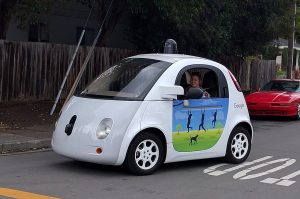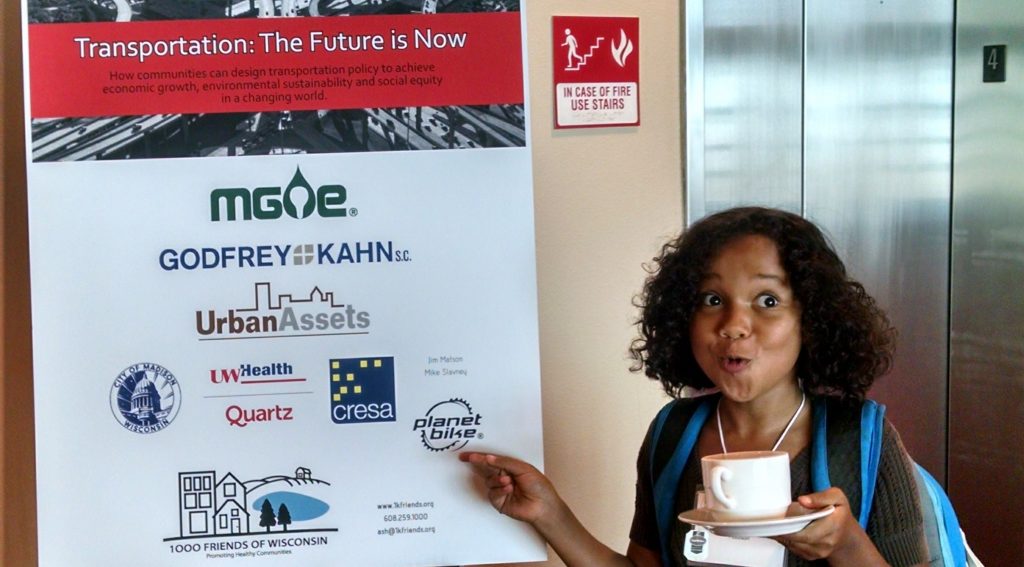Transportation – The Future is Now
Posted on Oct 11th 2017 | Advocacy, Bike Life, Blog,I had the pleasure to attend and present at 1000 Friends of Wisconsin’s recent Transportation: The Future Is Now conference in Madison, WI. In a nutshell, I spoke to how Autonomous Vehicles will slowly create a bump and then a tidal wave of biking and walking in our communities. Once a person replaces their old car with a shared Autonomous Vehicle, they will slowly shift their lifestyle to be more walking and biking focused. For more on my argument and the conference, read on.
Planet Bike sponsored this event because it’s important to get our heads around disruptive technologies so we are prepared to steer the unintended consequences, both good and bad, in ways that enhance our communities.

Photo by Grendelkhan CC BY-SA 4.0
Key themes of the conference were the changing demographics of the United States, the coming age of Autonomous Vehicles (AVs), the equitable distribution of transportation system benefits among rich and poor, the environmental sustainability of our transportation systems and how all these factors interact with each other. So, a lot to digest.
Effects on Walking and Biking
During my presentation I focused on how AVs will affect biking and walking and how we (through our governments) should respond to the uncertainty when AVs will arrive. Looking at how carsharing affected its customers’ lives gives some ideas about how AVs will play out. In a study by Zipcar, among carsharing customers:
- Walking increased 21%
- Biking increased 14%
- Transit use increased 11%
- 20% sold their car
AV sharing will be easier to use than a carsharing service such as Zipcar. Because of this ease, some fear people will AV more and walk/bike less. While some of that will happen, there’s an additional layer to how AVs will affect biking and walking.
Imagine you are AVing home from work and instead of going home you go to a restaurant. Afterwards, rather than calling another AV you decide to walk home. On the way you see that there’s a library near your home that you didn’t realize was there. Next Saturday morning, rather than call an AV you walk to the library and on the way you realize there’s a cool record shop or coffee shop just a few blocks away. Little walks between AV destinations will introduce people to their neighbors and local business, leading to more engagement and community building.
How Should we Respond
Some are skeptical that a computer can ever replace the skills of a human driver (No question). Others fear AVs will kill people (It’s bound to happen, but it will nevertheless increase safety compared to the current system in which sees 35,000 casualties annually). Will AVs reclaim cities for people or will they increase gridlock on our roads as people switch from transit and biking to AVs? Both will happen but to what extent may depend on how we regulate them.
As a city geek I am excited about AVs because they are sparking a great conversation about the future of our communities. In contrast, no one held conferences in the 1950s about the coming invasion of cul-de-sacs and now we are paying the price.
We need to remember that it is impossible to predict how this will play out. We should be very careful before spending lots of money to build infrastructure that may be obsolete in 10 years. It takes 20-30 years to pay off a parking garage. Should your city build a new one if they don’t know they will have the customers to pay for it? AVs can safely drive only a few feet from each other rather than the 60 feet required for human drivers, greatly reducing the feeling of congestion on a road without reducing car capacity. Should a city widen a busy road if in ten years AVs free up half the road space?
Change is coming. Keep calm and think it through.

The Future is Here
